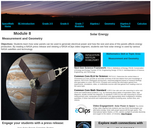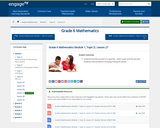
This parent guide supports parents in helping their child at home with the 6th grade Math content.
- Subject:
- Mathematics
- Material Type:
- Reference Material
- Author:
- Kelly Rawlston
- Letoria Lewis
- Date Added:
- 01/05/2022

This parent guide supports parents in helping their child at home with the 6th grade Math content.

This resource accompanies our Rethink 6th Grade Math course. It includes ideas for use, ways to support exceptional children, ways to extend learning, digital resources and tools, tips for supporting English Language Learners and students with visual and hearing impairments. There are also ideas for offline learning.

In this activity, students find the percent of a given number.

This unit is for an EC pull-put sixth grade math class. Students will represent the same value as a fraction, decimal, and percentage as they label each continent on a map with the percentage of the world's population in each continent, based on information from the book, "If the World Were a Village." Students will discuss the distribution of populations around the globe and how that impacts those areas of the world differently.This lesson was developed by Virginia Campbell as part of their completion of the North Carolina Global Educator Digital Badge program. This lesson plan has been vetted at the local and state level for standards alignment, Global Education focus, and content accuracy.

This unit is for an EC pull-put sixth grade math class. Students have a discussion connecting their lives to the globe. They then discuss the concept of scale as it relates to maps/globes and the book "If the World Were a Village." Finally they use a graphic organizer to predict what the book is going to tell them about the people of the world.This lesson was developed by Virginia Campbell as part of their completion of the North Carolina Global Educator Digital Badge program. This lesson plan has been vetted at the local and state level for standards alignment, Global Education focus, and content accuracy.

This unit is for an EC pull-put sixth grade math class. Students present their poster projects to the class, and then write a reflection responding to the unit.This lesson was developed by Virginia Campbell as part of their completion of the North Carolina Global Educator Digital Badge program. This lesson plan has been vetted at the local and state level for standards alignment, Global Education focus, and content accuracy.

This unit is for an EC pull-put sixth grade math class. Teacher will model how to create a pie chart using data from the book, "If the World Were a Village." Then the class will create a pie chart together as guided practice. The class will draw conclusions about peoples' different experiences and perspectives from the data in the chart. The teacher will introduce the poster project to the students, and they will select a set of data from the book to create their own pie chart with. This lesson was developed by Virginia Campbell as part of their completion of the North Carolina Global Educator Digital Badge program. This lesson plan has been vetted at the local and state level for standards alignment, Global Education focus, and content accuracy.

This unit is for an EC pull-put sixth grade math class. In this lesson students create a pie chart from their chosen set of data and work on the other elements of the poster project, including interpreting and explaining the data.This lesson was developed by Virginia Campbell as part of their completion of the North Carolina Global Educator Digital Badge program. This lesson plan has been vetted at the local and state level for standards alignment, Global Education focus, and content accuracy.

Students will learn how many people in their community are classified as "food insecure" and what efforts are in place to help those people. Students will explore food wastage as an issue in the United States and will work with other members of the school and surrounding community to collect fruit or other items that would otherwise be wasted in the school cafeteria. Students will collect data about how much food is collected and then use proportions to determine how much food could be saved statewide if all schools participated for a whole school year.This lesson was developed by Rebecca Blanchard as part of their completion of the North Carolina Global Educator Digital Badge program. This lesson plan has been vetted at the local and state level for standards alignment, Global Education focus, and content accuracy.

Students will learn the definition of hunger, explore some of the hungriest countries in the world, and find the factors causing hunger. Students will also use proportions and percents to determine how many people at their school would be hungry if they lived in a particular country based on the percentage of hungry people in that country.This lesson was developed by Rebecca Blanchard as part of their completion of the North Carolina Global Educator Digital Badge program. This lesson plan has been vetted at the local and state level for standards alignment, Global Education focus, and content accuracy.

For this activity, students solve problems to determine the amount of discounts received on various items.

This is a set of three, one-page problems about the size and area of solar panels used to generate power. Learners will calculate area fractions to compare the sizes and distances of Jupiter's moons. Options are presented so that students may learn about the Juno mission through a NASA press release or about how solar energy is used by various NASA satellites and technology by viewing a NASA eClips video [3 min.]. This activity is part of the Space Math multi-media modules that integrate NASA press releases, NASA archival video, and mathematics problems targeted at specific math standards commonly encountered in middle school.

For this interactive, students solve problems to find percents. Students enter an answer and can click the Check Answer button to see if their answer is correct.

In this lesson, students find the percent of a quantity. Given a part and the percent, students solve problems involving finding the whole.

This course was created by the Rethink Education Content Development Team in partnership with the North Carolina Virtual Public Schools. This course is aligned to the NC Standards for 6th Grade Math.

This course was created by the Rethink Education Content Development Team in partnership with the North Carolina Virtual Public Schools. This course is aligned to the NC Standards for 6th Grade Math.

This course was created by the Rethink Education Content Development Team in partnership with the North Carolina Virtual Public Schools. This course is aligned to the NC Standards for 6th Grade Math.